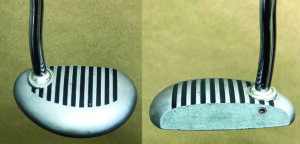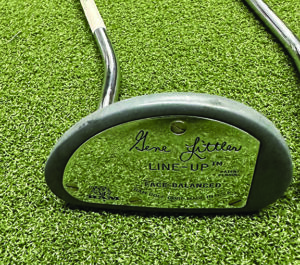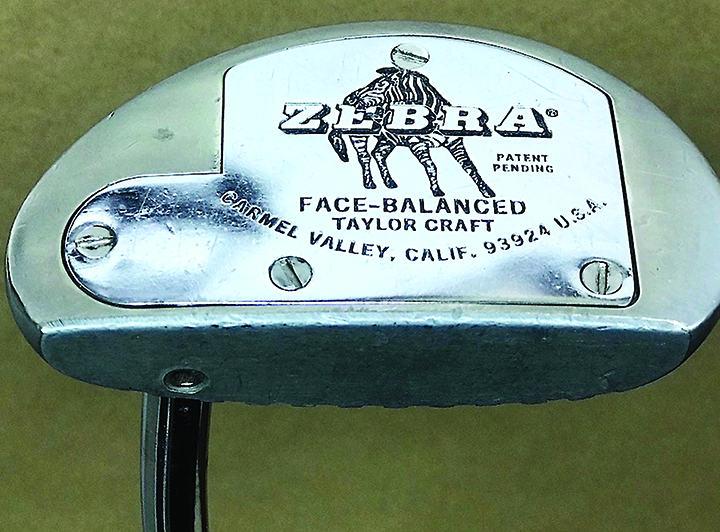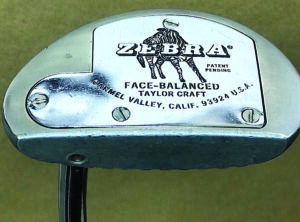
By Bobby Grace
The Golf, Winter 2023
Zebra Putters
Created by Dave Taylor, Carmel Valley, Calif.
Discovering rare Zebras of a different stripe
By far the most innovative mallet putter of the 1970s and 1980s is the adjustable Zebra Mallet. I started collecting Zebras in 1981 when I learned of the rarity of the inaugural edition, which had been deemed non-conforming by the USGA for its ball and socket adjustable shaft connection.
I first glimpsed a Zebra in 1975 when I was 15 years old. Larry Bulger, one of the better players at my neighborhood course, Pasadena Golf Club in St. Pete (Fla.), had recently become the RAM sales representative. He was a very large, loud man, and he ran around the green touting this prototype new mallet as the greatest invention in putter history.
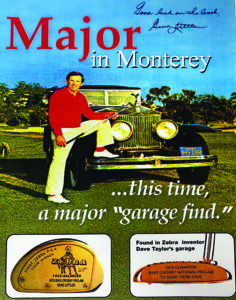
Well, he wasn’t wrong. Gene Littler (above) had just won the Crosby at Pebble Beach using a Zebra that Dave Taylor custom made for him before introducing it to the public. By the time I saw it, enough buzz had been generated to indicate it was taking off, and it wasn’t even due on the market for months.
I was fascinated by its unusual design with the sight-lines across the top; the double bend shaft (“Face Balanced,” he called it) and the shiny soleplate that was removable so you could add large heavy washers to drastically increase the weight if desired. This thing was as high-tech as you could imagine, and it worked.
The only thing I didn’t like was the rock hard feel. It felt like a brick on a stick. Feel to me was huge, as I putted with an Armour 3852 straight neck from the early 1940s that was forged from mild carbon steel and felt wonderful. The Zebra was die-cast from a metal known as pot metal and was quite hard and brittle.
I later learned that many Tour Players like a hard “click” off the face, particularly the sound it makes.
This very first Zebra is known as the “PENINSULA SOLEPLATE” because the soleplate is unlike that of any other Zebras and does not bear the RAM GOLF imprint (the Taylors still owned 100% of the brand).
It also has a different color (instead of the usual grey it is almost tan).
The ball and socket connection has a little ring around the top that was prone to crack under stress due to over-tightening. This explains the rarity of original first year Peninsula Sole-plate designs, as they could not be repaired once they cracked. After months of Tour success, the adjustable Zebra was initially ruled non-conforming by the USGA. The remedy was to pin the shaft into place from the face side, thus permanently affixing it and making it conform to the rules of golf.
In 1976, RAM purchased the company, allowing the Taylors to focus on the Tour Players’ needs to further refine the Zebra and increase its popularity. This year-two model still incorporated the ball and socket adjustable shaft design but featured an instructional paragraph on the soleplate describing what had to be done to make the putter conform to the rules. It is known as the ‘PARAGRAPH SOLEPLATE” model.
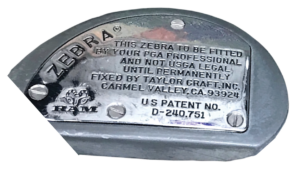
The customer would purchase the putter, his Golf Pro would fit it to his lie and loft and then send it to Taylor Craft to be pinned permanently, thus making it tournament ready. And tournament ready it was! Raymond Floyd won the 1976 Masters using his adjustable Zebra and set the Zebra world on fire.
Later, you would see every Pro who would even consider using a mallet trying the Zebra.
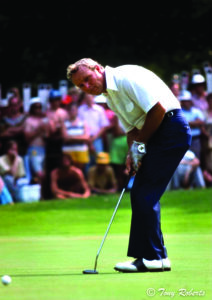
I discovered another very cool and collectible Zebra about five years ago through a good friend with whom I occasion- ally trade clubs. The story behind it particularly resonated with me, because I own a putter company and have invested close to $500,000 on patents and trademarks to protect my brand and putter designs worldwide.
When the Zebra took off in 1975-76 due to Gene Littler’s victory, the name was only trademarked in the USA. Some very shrewd businessman immediately trademarked “ZE- BRA” in class 28 (golf putters and products) in Japan. By this time, RAM had purchased distributorship worldwide and received huge orders from Japan! They were excited to ship the first 5,000 units as fast as they could, only to be halted at the border. Japanese customs would not allow these putters to enter the country due to the infringement of the Japanese Trademark already on file. The fast-thinking Hans- berger team figured out how they could remedy this huge problem by changing the name of the putter for Japan sales only and making special soleplates that read “Gene Littler Lineup” instead of Zebra. The putter was identical – only the soleplate was switched to allow these putters to enter Japan and be sold.
I have one of these and prize it because of this story, which has perhaps the happiest ending of any story in the history of putter manufacturing.
